31- 常用于移动设备的 MobileNet (TensorFlow系列) (深度学习)
迪丽瓦拉
2024-05-29 06:28:38
0次
知识要点
-
MobileNet网络是由google团队在2017年提出的,专注于移动端或者嵌入式设备中的轻量级CNN网络。
-
DW卷积: keras.layers.DepthwiseConv2D(3, activation='relu', padding='same')
一 MobileNet详解
1.1 简介
传统卷积神经网络,内存需求大、运算量大导致无法在移动设备以及嵌入式设备上运行.
MobileNet网络是由google团队在2017年提出的,专注于移动端或者嵌入 式设备中的轻量级CNN网络。相比传统卷积神经网络,在准确率小幅降低的前提下大大减少模型参数与运算量。(相比VGG16准确率减少了0.9%, 但模型参数只有VGG的1/32)

MobileNet 网络中的亮点:
- Depthwise Convolution (大大减少运算量和参数数量)
- 增加超参数α、β
1.2 卷积特征对比
传统卷积:
- 卷积核channel=输入特征矩阵channel
- 输出特征矩阵channel=卷积核个数
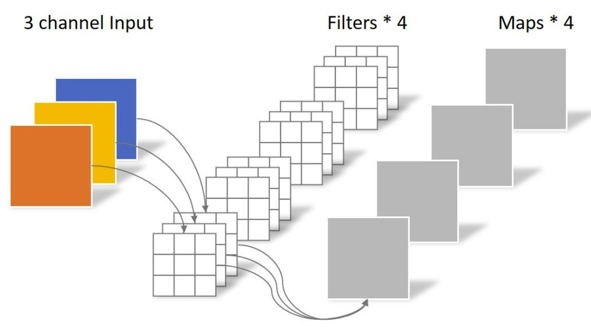
DW卷积 Depthwise Conv:
- 卷积核channel=1
- 输入特征矩阵channel=卷积核个数=输出特征矩阵channel
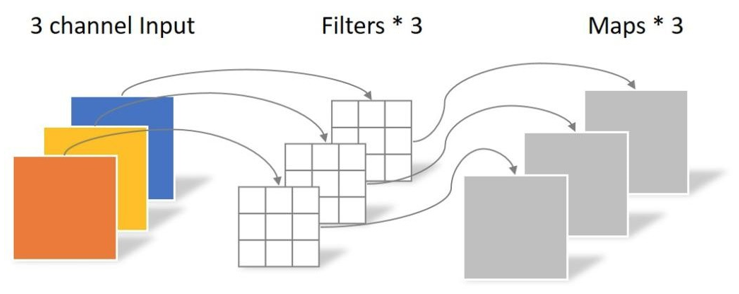
PW卷积 Pointwise Conv
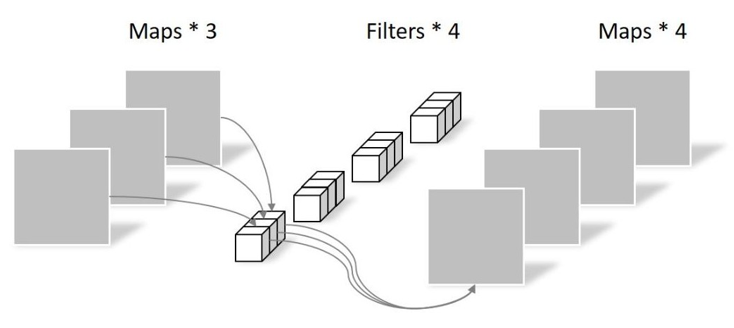
理论上普通卷积计算量是DW+PW的8到9倍
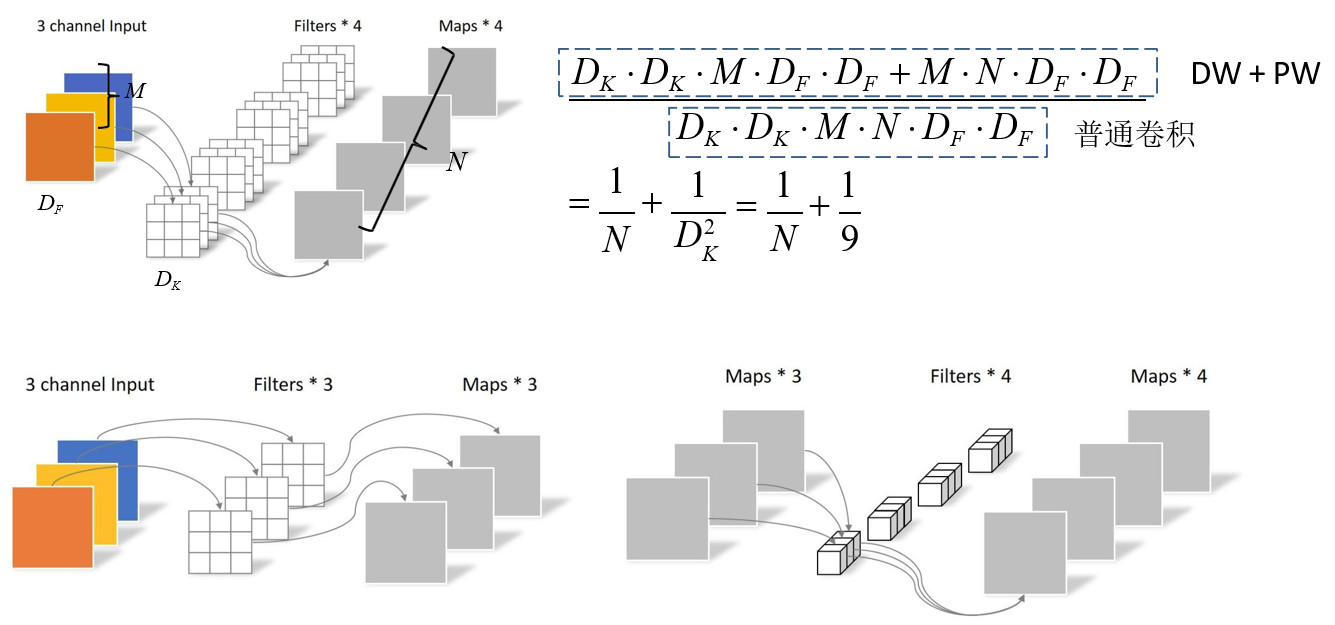
1.3 模型参数
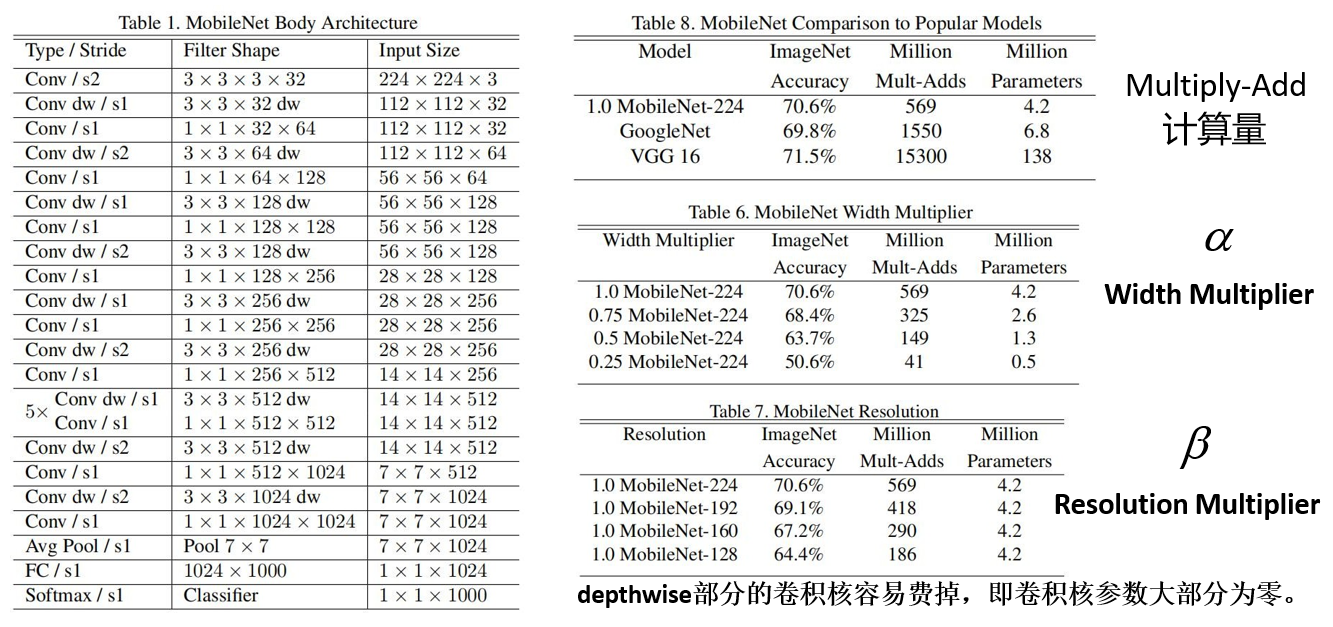
1.4 代码实现 (DW卷积)
- 导包
from tensorflow import keras
import tensorflow as tf
import numpy as np
import pandas as pd
import matplotlib.pyplot as plt- 传统卷积
model = keras.Sequential([keras.layers.Input(shape = (28, 28, 3), dtype = 'float32'),keras.layers.Conv2D(32, 3, activation='relu', padding='same', use_bias=False) # 卷积
])
model.summary()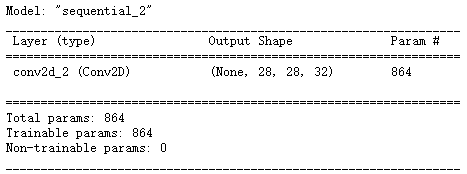
- DW卷积
model = keras.Sequential([keras.layers.Input(shape = (28, 28, 3), dtype = 'float32'),keras.layers.DepthwiseConv2D(3, activation='relu', padding='same') # DW卷积
])
model.summary() 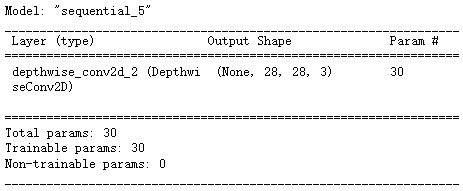
- DW+ PW深度可分离卷积
# DW+ PW深度可分离卷积
model = keras.Sequential([keras.layers.Input(shape = (28, 28, 3), dtype = 'float32'),keras.layers.SeparableConv2D(32, 3, activation='relu', padding='same', use_bias=False) # DW卷积
])
model.summary()
二 MobileNet v2
2.1 MobileNet V2版
MobileNet v2网络是由google团队在2018年提出的,相比MobileNet V1网 络,准确率更高,模型更小。

网络中的亮点:
- Inverted Residuals(倒残差结构)
- Linear Bottlenecks
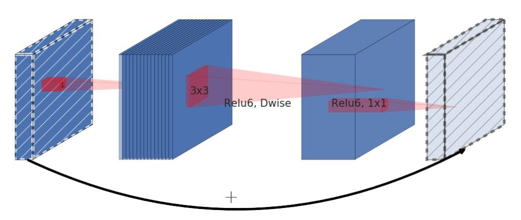
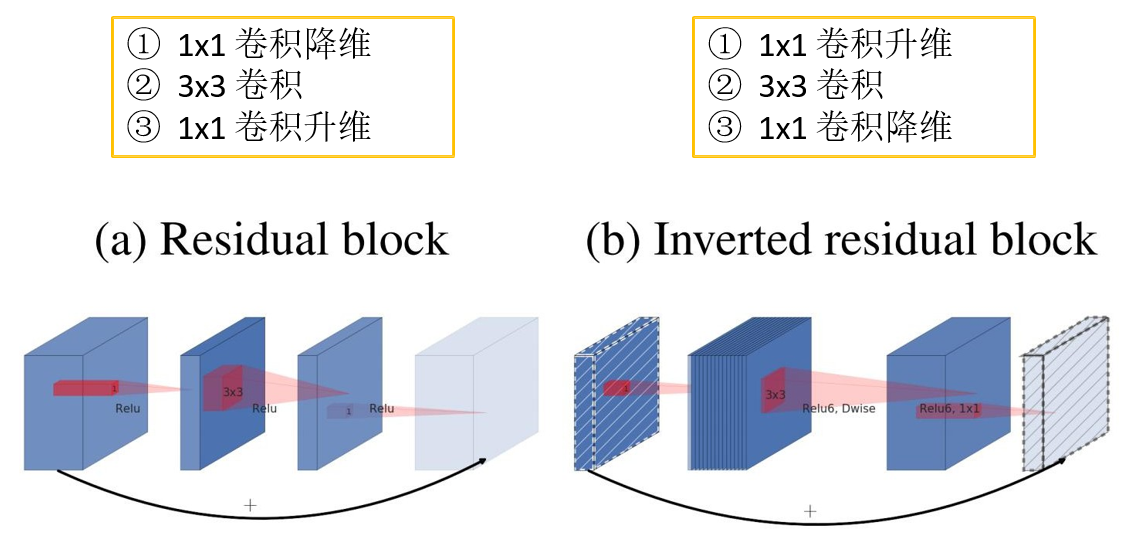
2.2 ReLU6(x)
-
y = ReLU6(x) = min(max(x, 0), 6)
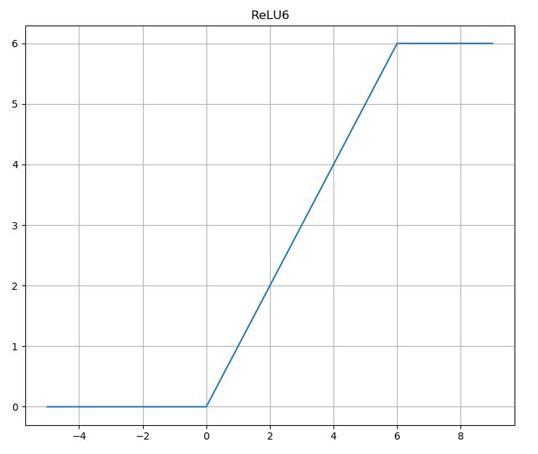
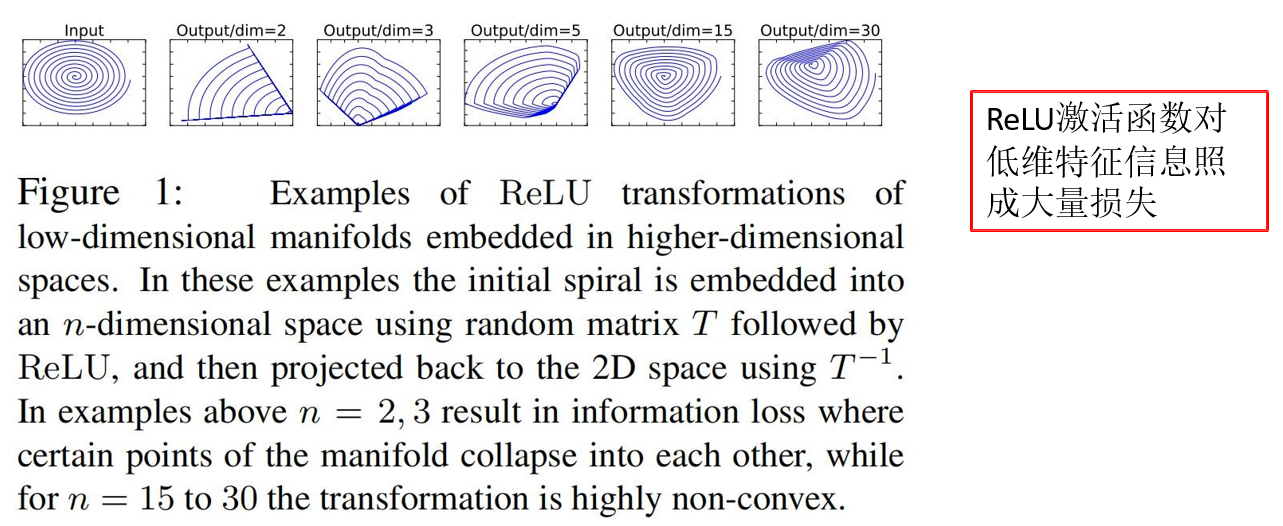
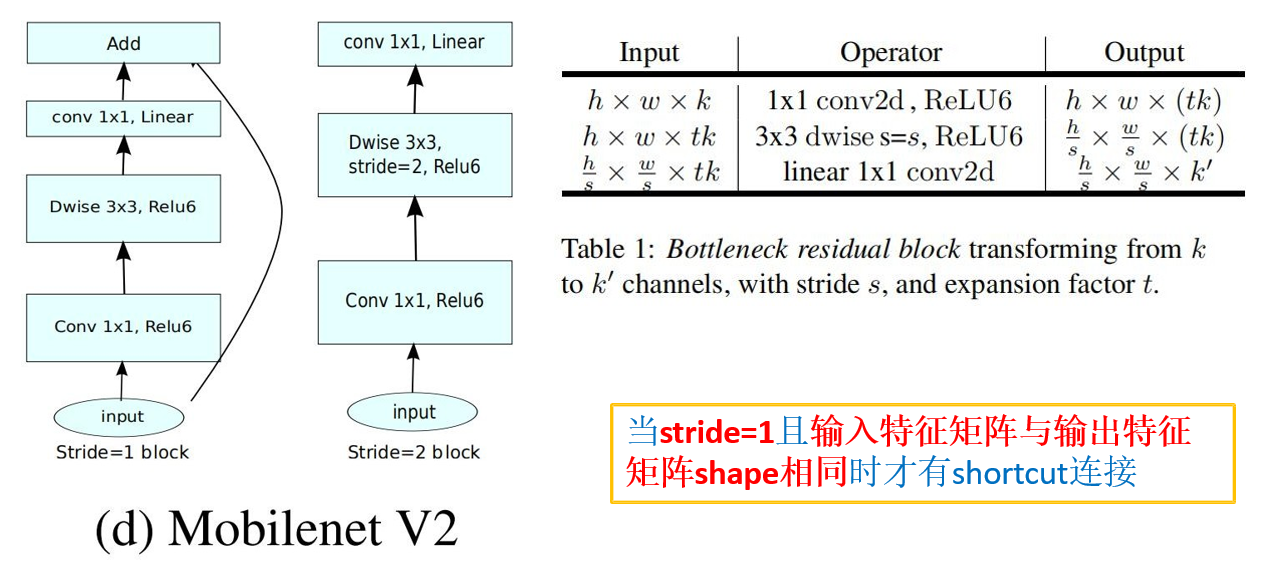
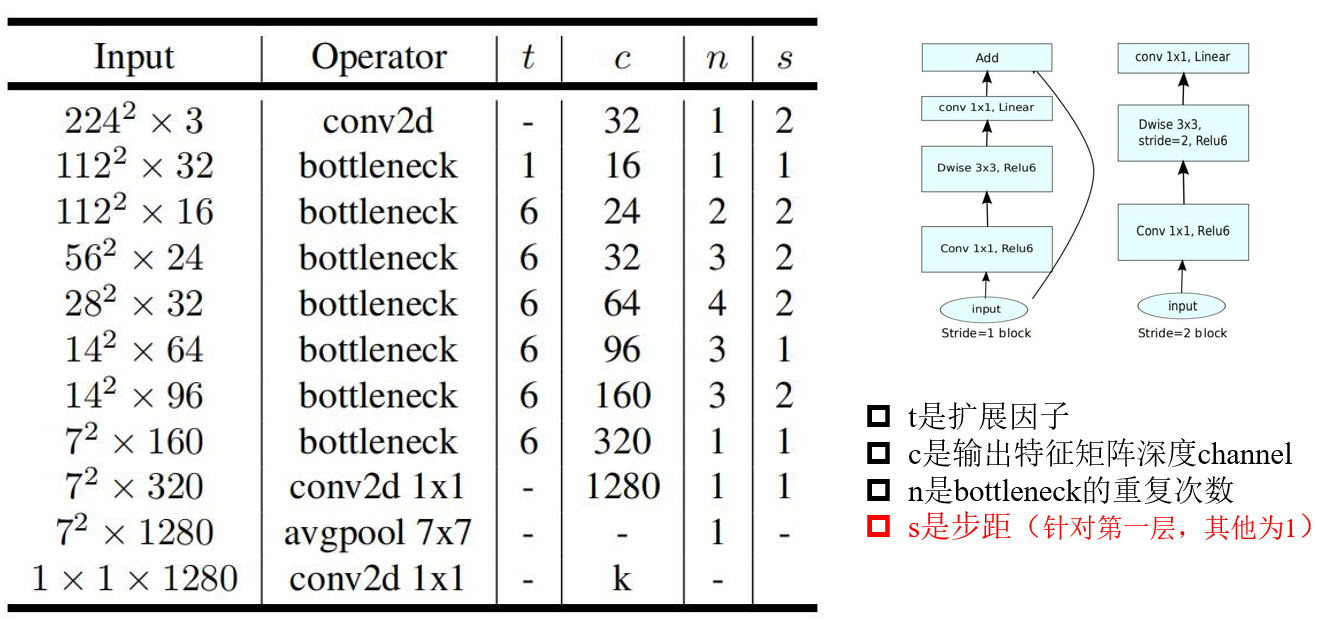
2.3 代码实现
from tensorflow.keras import layers, Model, Sequentialdef _make_divisible(ch, divisor=8, min_ch=None):"""This function is taken from the original tf repo.It ensures that all layers have a channel number that is divisible by 8It can be seen here:https://github.com/tensorflow/models/blob/master/research/slim/nets/mobilenet/mobilenet.py"""if min_ch is None:min_ch = divisornew_ch = max(min_ch, int(ch + divisor / 2) // divisor * divisor)# Make sure that round down does not go down by more than 10%.if new_ch < 0.9 * ch:new_ch += divisorreturn new_chclass ConvBNReLU(layers.Layer):def __init__(self, out_channel, kernel_size=3, stride=1, **kwargs):super(ConvBNReLU, self).__init__(**kwargs)self.conv = layers.Conv2D(filters=out_channel, kernel_size=kernel_size,strides=stride, padding='SAME', use_bias=False, name='Conv2d')self.bn = layers.BatchNormalization(momentum=0.9, epsilon=1e-5, name='BatchNorm')self.activation = layers.ReLU(max_value=6.0)def call(self, inputs, training=False):x = self.conv(inputs)x = self.bn(x, training=training)x = self.activation(x)return xclass InvertedResidual(layers.Layer):def __init__(self, in_channel, out_channel, stride, expand_ratio, **kwargs):super(InvertedResidual, self).__init__(**kwargs)self.hidden_channel = in_channel * expand_ratioself.use_shortcut = stride == 1 and in_channel == out_channellayer_list = []if expand_ratio != 1:# 1x1 pointwise convlayer_list.append(ConvBNReLU(out_channel=self.hidden_channel, kernel_size=1, name='expand'))layer_list.extend([# 3x3 depthwise convlayers.DepthwiseConv2D(kernel_size=3, padding='SAME', strides=stride,use_bias=False, name='depthwise'),layers.BatchNormalization(momentum=0.9, epsilon=1e-5, name='depthwise/BatchNorm'),layers.ReLU(max_value=6.0),# 1x1 pointwise conv(linear)layers.Conv2D(filters=out_channel, kernel_size=1, strides=1,padding='SAME', use_bias=False, name='project'),layers.BatchNormalization(momentum=0.9, epsilon=1e-5, name='project/BatchNorm')])self.main_branch = Sequential(layer_list, name='expanded_conv')def call(self, inputs, training=False, **kwargs):if self.use_shortcut:return inputs + self.main_branch(inputs, training=training)else:return self.main_branch(inputs, training=training)def MobileNetV2(im_height=224,im_width=224,num_classes=1000,alpha=1.0,round_nearest=8,include_top=True):block = InvertedResidualinput_channel = _make_divisible(32 * alpha, round_nearest)last_channel = _make_divisible(1280 * alpha, round_nearest)inverted_residual_setting = [# t, c, n, s[1, 16, 1, 1],[6, 24, 2, 2],[6, 32, 3, 2],[6, 64, 4, 2],[6, 96, 3, 1],[6, 160, 3, 2],[6, 320, 1, 1],]input_image = layers.Input(shape=(im_height, im_width, 3), dtype='float32')# conv1x = ConvBNReLU(input_channel, stride=2, name='Conv')(input_image)# building inverted residual residual blockesfor idx, (t, c, n, s) in enumerate(inverted_residual_setting):output_channel = _make_divisible(c * alpha, round_nearest)for i in range(n):stride = s if i == 0 else 1x = block(x.shape[-1],output_channel,stride,expand_ratio=t)(x)# building last several layersx = ConvBNReLU(last_channel, kernel_size=1, name='Conv_1')(x)if include_top is True:# building classifierx = layers.GlobalAveragePooling2D()(x) # pool + flattenx = layers.Dropout(0.2)(x)output = layers.Dense(num_classes, name='Logits')(x)else:output = xmodel = Model(inputs=input_image, outputs=output)return model三 模型实例
3.1 分类模型 (Classification)
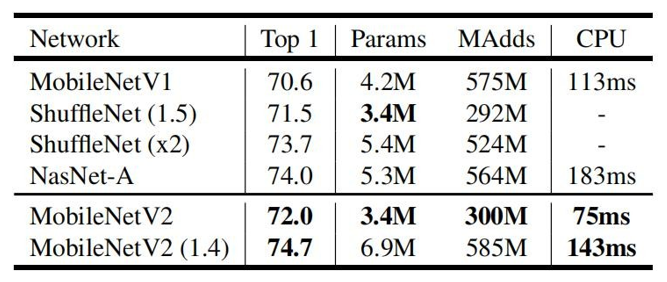
3.2 对象检测 (Object Detection)
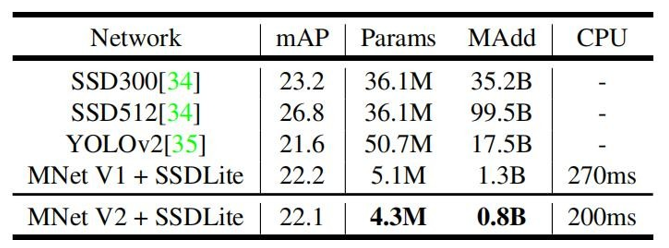
四 MobileNet V3
4.1 简介
网络中的亮点:
- 更新Block(bneck)
- 使用NAS搜索参数 (Neural Architecture Search).
- 重新设计耗时层结构.
-
重新设计激活函数.

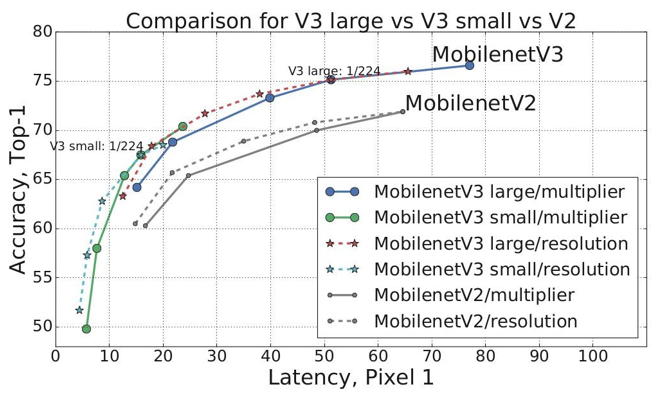
4.2 神经网络
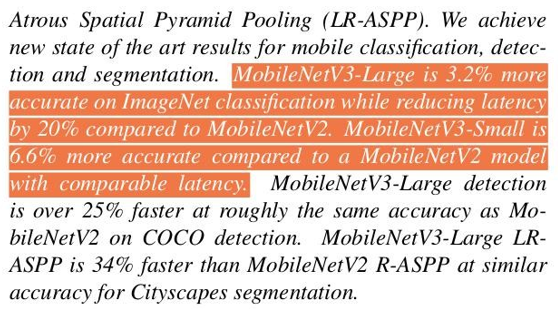
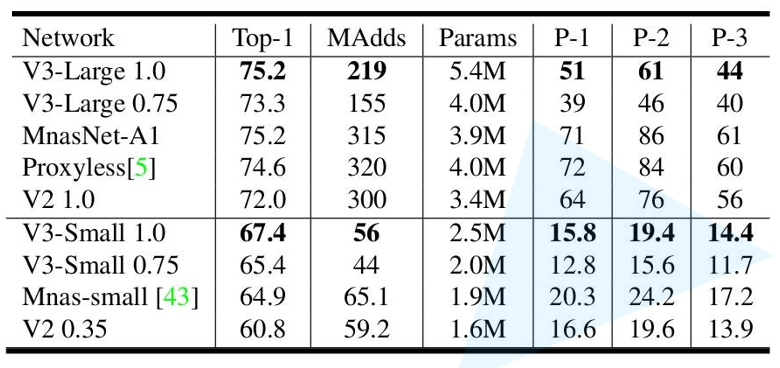
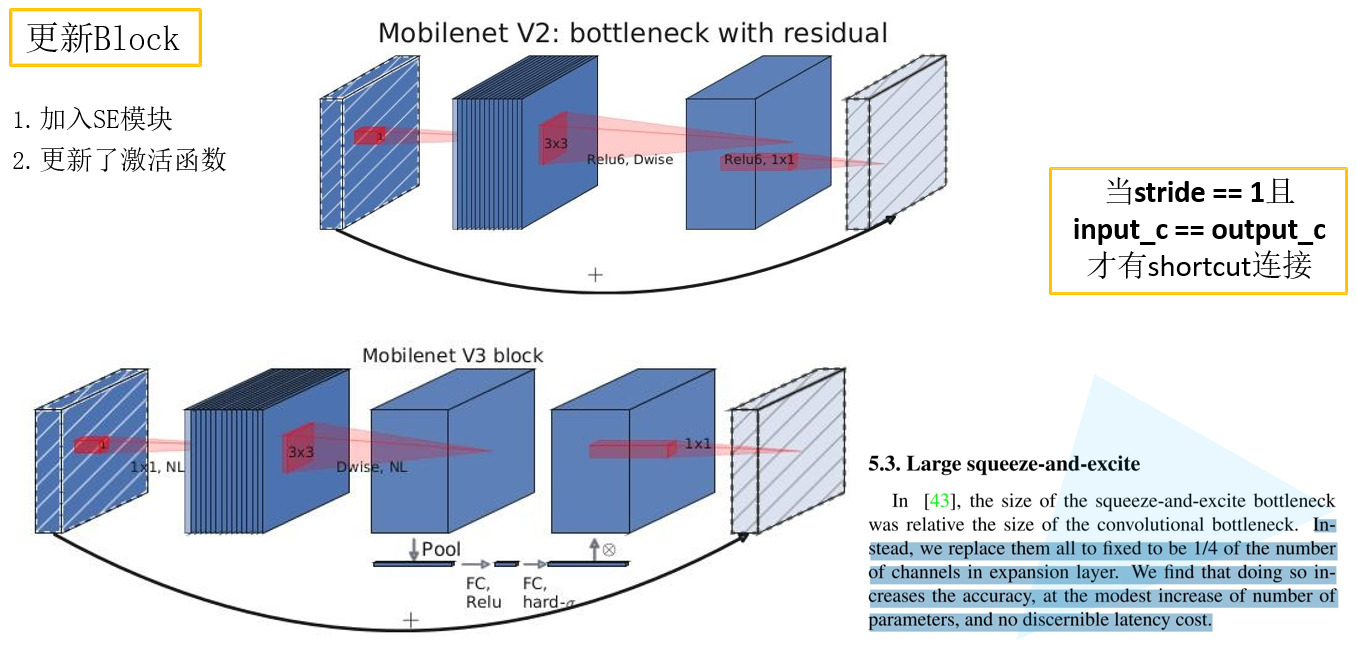
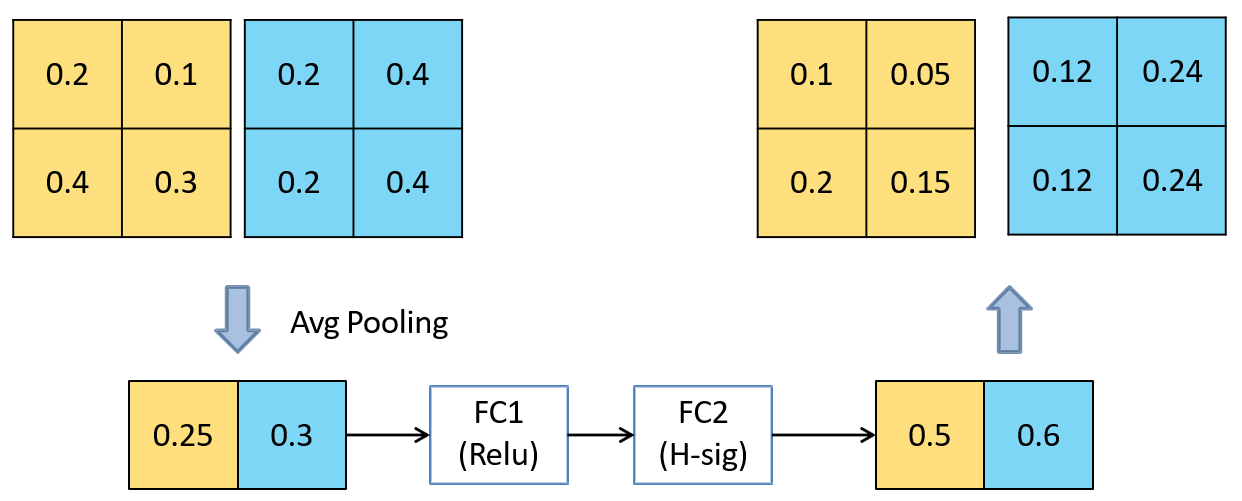
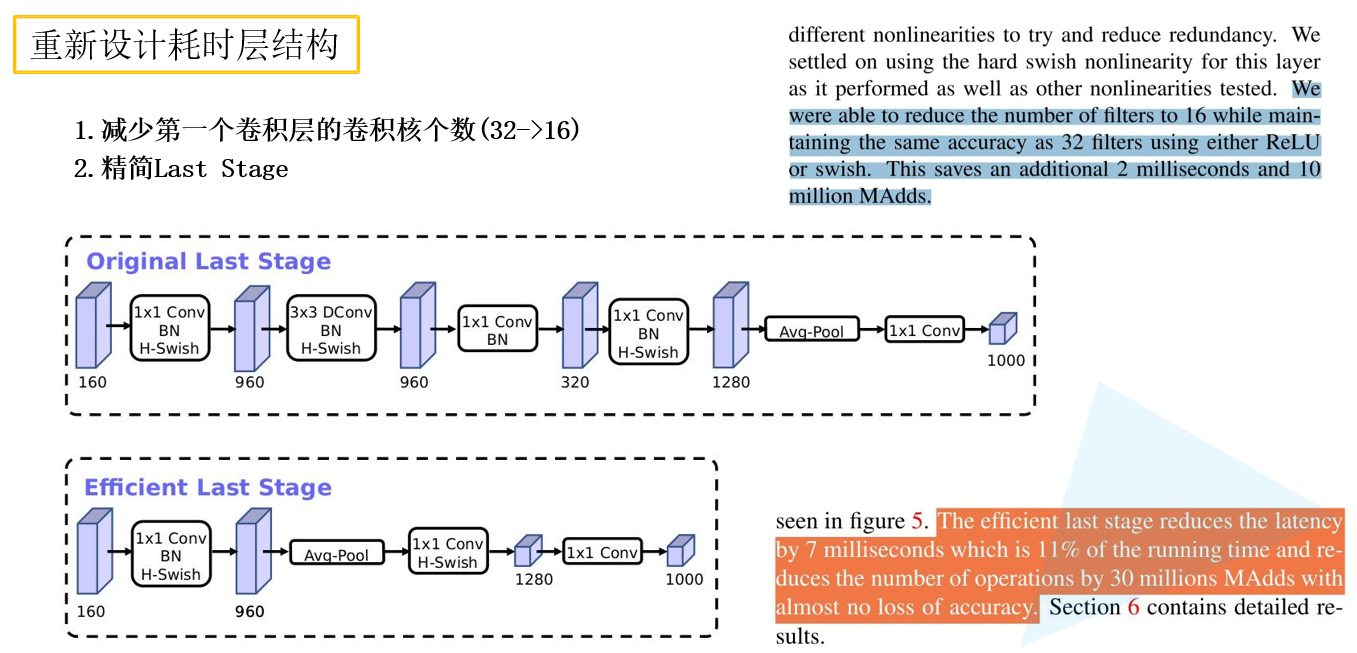
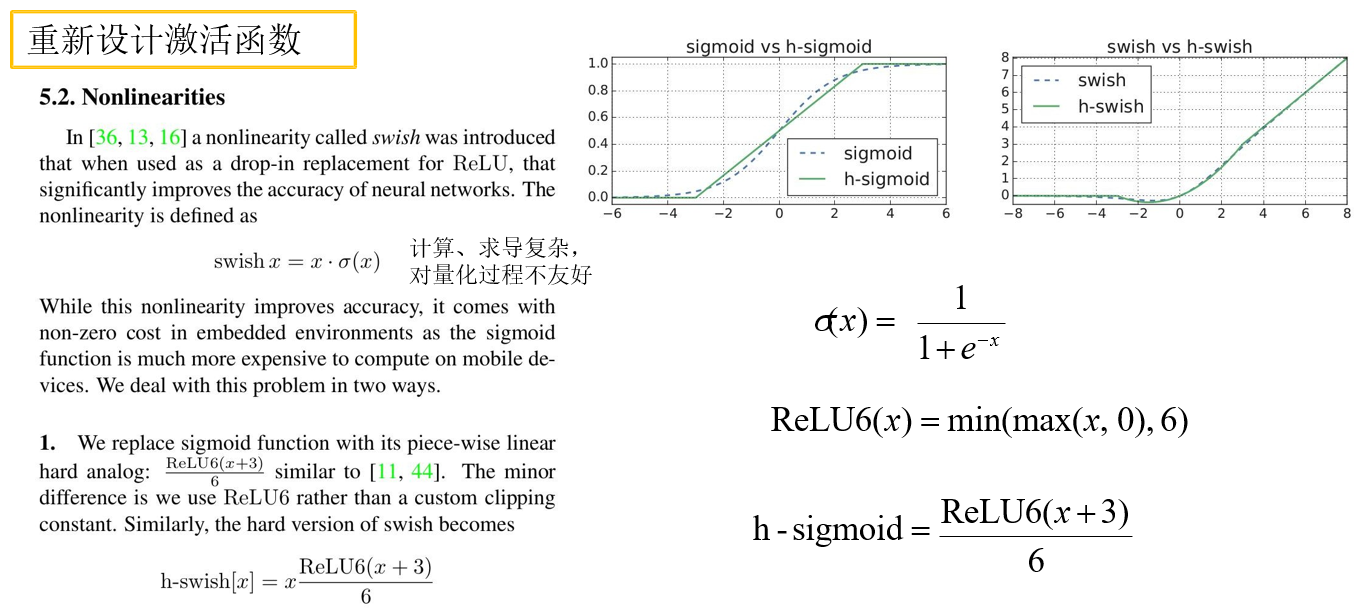
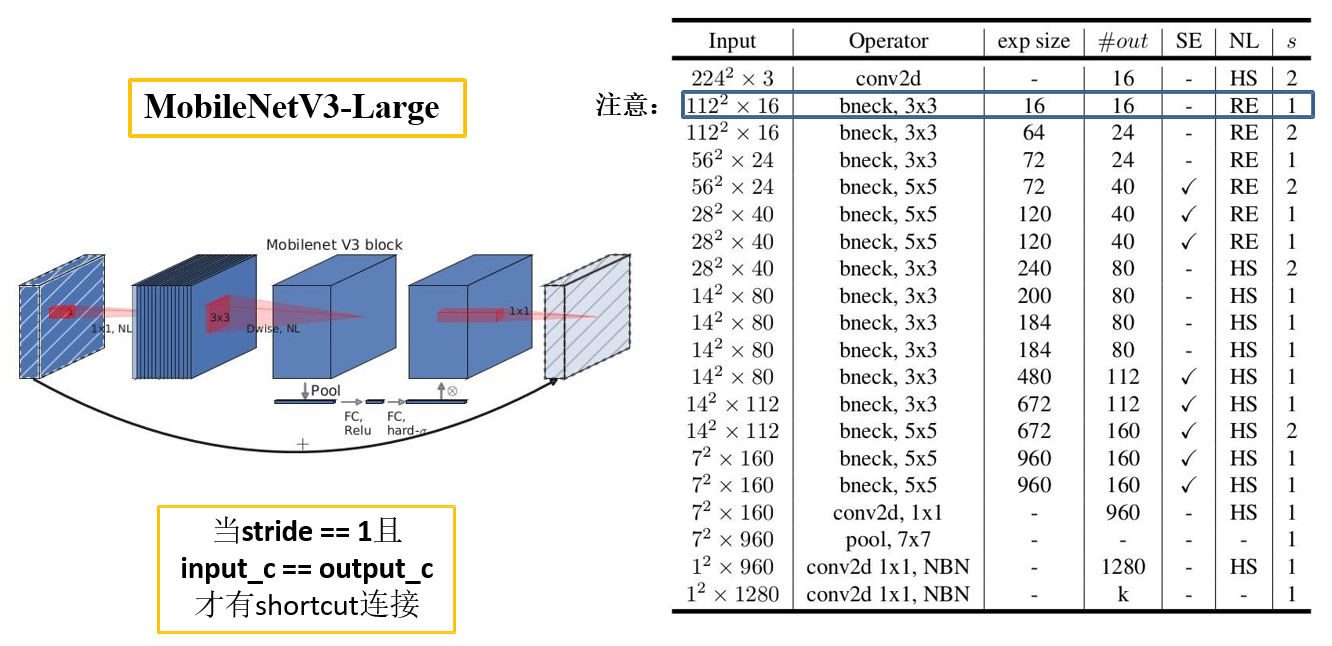
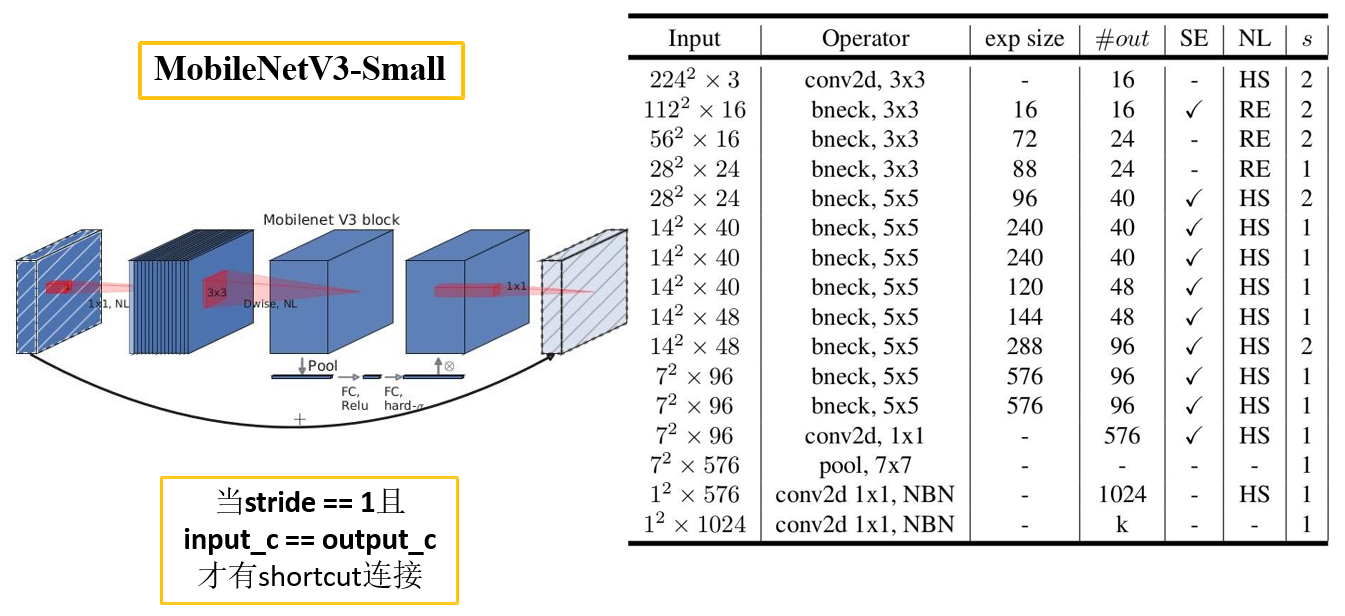
4.3 代码实现
from typing import Union
from functools import partial
from tensorflow.keras import layers, Modeldef _make_divisible(ch, divisor=8, min_ch=None):"""This function is taken from the original tf repo.It ensures that all layers have a channel number that is divisible by 8It can be seen here:https://github.com/tensorflow/models/blob/master/research/slim/nets/mobilenet/mobilenet.py"""if min_ch is None:min_ch = divisornew_ch = max(min_ch, int(ch + divisor / 2) // divisor * divisor)# Make sure that round down does not go down by more than 10%.if new_ch < 0.9 * ch:new_ch += divisorreturn new_chdef correct_pad(input_size: Union[int, tuple], kernel_size: int):"""Returns a tuple for zero-padding for 2D convolution with downsampling.Arguments:input_size: Input tensor size.kernel_size: An integer or tuple/list of 2 integers.Returns:A tuple."""if isinstance(input_size, int):input_size = (input_size, input_size)kernel_size = (kernel_size, kernel_size)adjust = (1 - input_size[0] % 2, 1 - input_size[1] % 2)correct = (kernel_size[0] // 2, kernel_size[1] // 2)return ((correct[0] - adjust[0], correct[0]),(correct[1] - adjust[1], correct[1]))class HardSigmoid(layers.Layer):def __init__(self, **kwargs):super(HardSigmoid, self).__init__(**kwargs)self.relu6 = layers.ReLU(6.)def call(self, inputs, **kwargs):x = self.relu6(inputs + 3) * (1. / 6)return xclass HardSwish(layers.Layer):def __init__(self, **kwargs):super(HardSwish, self).__init__(**kwargs)self.hard_sigmoid = HardSigmoid()def call(self, inputs, **kwargs):x = self.hard_sigmoid(inputs) * inputsreturn xdef _se_block(inputs, filters, prefix, se_ratio=1 / 4.):# [batch, height, width, channel] -> [batch, channel]x = layers.GlobalAveragePooling2D(name=prefix + 'squeeze_excite/AvgPool')(inputs)# Target shape. Tuple of integers, does not include the samples dimension (batch size).# [batch, channel] -> [batch, 1, 1, channel]x = layers.Reshape((1, 1, filters))(x)# fc1x = layers.Conv2D(filters=_make_divisible(filters * se_ratio),kernel_size=1,padding='same',name=prefix + 'squeeze_excite/Conv')(x)x = layers.ReLU(name=prefix + 'squeeze_excite/Relu')(x)# fc2x = layers.Conv2D(filters=filters,kernel_size=1,padding='same',name=prefix + 'squeeze_excite/Conv_1')(x)x = HardSigmoid(name=prefix + 'squeeze_excite/HardSigmoid')(x)x = layers.Multiply(name=prefix + 'squeeze_excite/Mul')([inputs, x])return xdef _inverted_res_block(x,input_c: int, # input channelkernel_size: int, # kennel sizeexp_c: int, # expanded channelout_c: int, # out channeluse_se: bool, # whether using SEactivation: str, # RE or HSstride: int,block_id: int,alpha: float = 1.0):bn = partial(layers.BatchNormalization, epsilon=0.001, momentum=0.99)input_c = _make_divisible(input_c * alpha)exp_c = _make_divisible(exp_c * alpha)out_c = _make_divisible(out_c * alpha)act = layers.ReLU if activation == "RE" else HardSwishshortcut = xprefix = 'expanded_conv/'if block_id:# expand channelprefix = 'expanded_conv_{}/'.format(block_id)x = layers.Conv2D(filters=exp_c,kernel_size=1,padding='same',use_bias=False,name=prefix + 'expand')(x)x = bn(name=prefix + 'expand/BatchNorm')(x)x = act(name=prefix + 'expand/' + act.__name__)(x)if stride == 2:input_size = (x.shape[1], x.shape[2]) # height, widthx = layers.ZeroPadding2D(padding=correct_pad(input_size, kernel_size),name=prefix + 'depthwise/pad')(x)x = layers.DepthwiseConv2D(kernel_size=kernel_size,strides=stride,padding='same' if stride == 1 else 'valid',use_bias=False,name=prefix + 'depthwise')(x)x = bn(name=prefix + 'depthwise/BatchNorm')(x)x = act(name=prefix + 'depthwise/' + act.__name__)(x)if use_se:x = _se_block(x, filters=exp_c, prefix=prefix)x = layers.Conv2D(filters=out_c,kernel_size=1,padding='same',use_bias=False,name=prefix + 'project')(x)x = bn(name=prefix + 'project/BatchNorm')(x)if stride == 1 and input_c == out_c:x = layers.Add(name=prefix + 'Add')([shortcut, x])return xdef mobilenet_v3_large(input_shape=(224, 224, 3),num_classes=1000,alpha=1.0,include_top=True):"""download weights url:链接: https://pan.baidu.com/s/13uJznKeqHkjUp72G_gxe8Q 密码: 8quu"""bn = partial(layers.BatchNormalization, epsilon=0.001, momentum=0.99)img_input = layers.Input(shape=input_shape)x = layers.Conv2D(filters=16,kernel_size=3,strides=(2, 2),padding='same',use_bias=False,name="Conv")(img_input)x = bn(name="Conv/BatchNorm")(x)x = HardSwish(name="Conv/HardSwish")(x)inverted_cnf = partial(_inverted_res_block, alpha=alpha)# input, input_c, k_size, expand_c, use_se, activation, stride, block_idx = inverted_cnf(x, 16, 3, 16, 16, False, "RE", 1, 0)x = inverted_cnf(x, 16, 3, 64, 24, False, "RE", 2, 1)x = inverted_cnf(x, 24, 3, 72, 24, False, "RE", 1, 2)x = inverted_cnf(x, 24, 5, 72, 40, True, "RE", 2, 3)x = inverted_cnf(x, 40, 5, 120, 40, True, "RE", 1, 4)x = inverted_cnf(x, 40, 5, 120, 40, True, "RE", 1, 5)x = inverted_cnf(x, 40, 3, 240, 80, False, "HS", 2, 6)x = inverted_cnf(x, 80, 3, 200, 80, False, "HS", 1, 7)x = inverted_cnf(x, 80, 3, 184, 80, False, "HS", 1, 8)x = inverted_cnf(x, 80, 3, 184, 80, False, "HS", 1, 9)x = inverted_cnf(x, 80, 3, 480, 112, True, "HS", 1, 10)x = inverted_cnf(x, 112, 3, 672, 112, True, "HS", 1, 11)x = inverted_cnf(x, 112, 5, 672, 160, True, "HS", 2, 12)x = inverted_cnf(x, 160, 5, 960, 160, True, "HS", 1, 13)x = inverted_cnf(x, 160, 5, 960, 160, True, "HS", 1, 14)last_c = _make_divisible(160 * 6 * alpha)last_point_c = _make_divisible(1280 * alpha)x = layers.Conv2D(filters=last_c,kernel_size=1,padding='same',use_bias=False,name="Conv_1")(x)x = bn(name="Conv_1/BatchNorm")(x)x = HardSwish(name="Conv_1/HardSwish")(x)if include_top is True:x = layers.GlobalAveragePooling2D()(x)x = layers.Reshape((1, 1, last_c))(x)# fc1x = layers.Conv2D(filters=last_point_c,kernel_size=1,padding='same',name="Conv_2")(x)x = HardSwish(name="Conv_2/HardSwish")(x)# fc2x = layers.Conv2D(filters=num_classes,kernel_size=1,padding='same',name='Logits/Conv2d_1c_1x1')(x)x = layers.Flatten()(x)x = layers.Softmax(name="Predictions")(x)model = Model(img_input, x, name="MobilenetV3large")return modeldef mobilenet_v3_small(input_shape=(224, 224, 3),num_classes=1000,alpha=1.0,include_top=True):"""download weights url:链接: https://pan.baidu.com/s/1vrQ_6HdDTHL1UUAN6nSEcw 密码: rrf0"""bn = partial(layers.BatchNormalization, epsilon=0.001, momentum=0.99)img_input = layers.Input(shape=input_shape)x = layers.Conv2D(filters=16,kernel_size=3,strides=(2, 2),padding='same',use_bias=False,name="Conv")(img_input)x = bn(name="Conv/BatchNorm")(x)x = HardSwish(name="Conv/HardSwish")(x)inverted_cnf = partial(_inverted_res_block, alpha=alpha)# input, input_c, k_size, expand_c, use_se, activation, stride, block_idx = inverted_cnf(x, 16, 3, 16, 16, True, "RE", 2, 0)x = inverted_cnf(x, 16, 3, 72, 24, False, "RE", 2, 1)x = inverted_cnf(x, 24, 3, 88, 24, False, "RE", 1, 2)x = inverted_cnf(x, 24, 5, 96, 40, True, "HS", 2, 3)x = inverted_cnf(x, 40, 5, 240, 40, True, "HS", 1, 4)x = inverted_cnf(x, 40, 5, 240, 40, True, "HS", 1, 5)x = inverted_cnf(x, 40, 5, 120, 48, True, "HS", 1, 6)x = inverted_cnf(x, 48, 5, 144, 48, True, "HS", 1, 7)x = inverted_cnf(x, 48, 5, 288, 96, True, "HS", 2, 8)x = inverted_cnf(x, 96, 5, 576, 96, True, "HS", 1, 9)x = inverted_cnf(x, 96, 5, 576, 96, True, "HS", 1, 10)last_c = _make_divisible(96 * 6 * alpha)last_point_c = _make_divisible(1024 * alpha)x = layers.Conv2D(filters=last_c,kernel_size=1,padding='same',use_bias=False,name="Conv_1")(x)x = bn(name="Conv_1/BatchNorm")(x)x = HardSwish(name="Conv_1/HardSwish")(x)if include_top is True:x = layers.GlobalAveragePooling2D()(x)x = layers.Reshape((1, 1, last_c))(x)# fc1x = layers.Conv2D(filters=last_point_c,kernel_size=1,padding='same',name="Conv_2")(x)x = HardSwish(name="Conv_2/HardSwish")(x)# fc2x = layers.Conv2D(filters=num_classes,kernel_size=1,padding='same',name='Logits/Conv2d_1c_1x1')(x)x = layers.Flatten()(x)x = layers.Softmax(name="Predictions")(x)model = Model(img_input, x, name="MobilenetV3large")return model
相关内容
热门资讯
Linux-scheduler...
四、调度域 SDTL结构 linux内核使用SDTL结构体来组织CPU的层次关系 struct sc...
Retinanet网络与foc...
参考代码:https://github.com/yhenon/pytorch-reti...